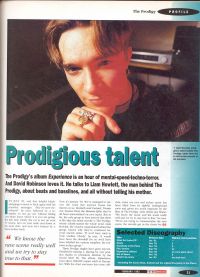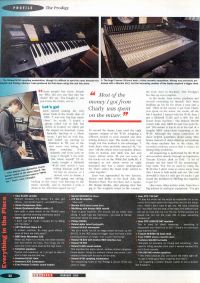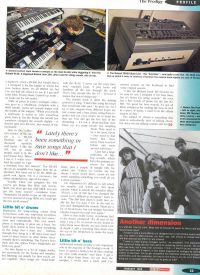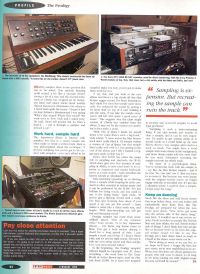Articles
The Prodigy related articles from magazines.
Future Music
Prodigious talent
Soon after the release of Experience, the band’s full-length debut, David Robinson sat down with Liam Howlett to get the story. The interview that follows was conducted in 1992, and serves as a fascinating insight into a band on the cusp of electronic music greatness.
It’s July ‘91, and that helpful black-and-ginger tomcat is back again with his screechy messages. ‘Mia-ow-aow-ow-oohaow!’ he cries, followed by a reminder to not go outside without letting your mum know where you’re going. But this time Charly the cat is not on your TV screen; he’s on your radio and in the clubs – and he’s backed by a fierce techno track.
Now it’s January ‘92. We’ve managed to survive the worst that toytown house has thrown at us: Roobarb and Custard, Trumpton, Sesame Street, the Banana Splits have all been immortalised on rave tracks. But so far, the only group to prove that there is life after the initial novelty is The Prodigy, whose Charly started the whole trend. Liam Howlett, the creative mastermind behind the group, knows why they’ve continued beyond one-hit status.
“If we’d have tried to write another Charly,” he says, “it would have been the downfall of us: we’d have been labelled the cartoon samplers, the toytown techno group.”
Three Prodigy singles have gone top ten, with Fire/Jericho only missing out by one position because their record label, XL Recordings, prematurely deleted it. Meanwhile their album, Experience, went silver (200,000 copies sold) in December. [Experience has since gone Platinum, exceeding 300,000 copies sold]
With the chart success, however, has come criticism. Some say that rave and techno music have been lifted from their underground roots and given too much exposure by the likes of The Prodigy. Liam denies any blame: “We know the music and the scene really well and we try to stay true to that,” he says. “We’re not trying to commercialise the rave scene; the records get into the charts because people buy them. People say ‘why did you put that record into the charts?’ We say ‘You bought it, you put it into the charts, not us.’”
Hip-hop to house
Liam started making his own music back in the heady days of 1986. “I was into hip-hop music than,” he recalls. “I joined a group called Cut To Kill, but down in London we didn’t get the respect we deserved. I got fed up with that, and ended up moving to Braintree in ’89, just as the rave scene was taking off.
“After watching N-Joi, Adamski and Guru Josh on stage, I thought ‘I can write this music myself!’ I’d already bought a [Roland] W-30 to write hip-hop stuff but I was having no success, so I moved over to house. I spent 1990 going out raving, looking at the scene and listening to the music carefully, and in October I took a demo to XL, who signed me up.”
To record the demo, Liam used the eight separate outputs of the W-30, assigning a different sample to each channel and then mixing down to tape. The results were very rough, but this worked to his advantage: “I think that’s probably what attracted XL,” he says. “All the others were top-quality demos, done in studios, and mine was raw and ropey, almost noisy.
XL put some of the tracks out as the What Evil Lurks EP; it managed to sell about seven or eight thousand and was a minor underground hit. That’s when the band really started to come together.”
Liam was approached by two dancers, Leeroy and Keith, at his local club, The Braintree Barn. The trio then met a rapper, MC Maxim Reality, after playing their first gig at “the roughest venue in the country”, the Four Aces in Hackney. The Prodigy’s live line-up was complete.
Equipped to kill
In the studio, Liam writes, produces and records everything by himself. He’s been building up his kit for about a year and a half. “Most of the money I got from Charly was spent on the mixer, the studio, all the bits I needed. I started with the W-30, then I got a [Roland] U-220 and a 909, the old house drum machine.”
All sequencing is performed by the W-30 and recorded directly through an impressive Tascam 32-track desk to DAT. “A lot of people use the Atari ST for sequencing,” says Liam, “but I’m so used to using the W-30 that I don’t want to move away from that; I know it inside out. The only downfall is that it’s only got 16 tracks; I get round it by MIDIing two together to get 32.”
Like every other techno artist, Liam has a big interest in analogue equipment. “I’ve got a Jupiter 8. I had a JD-800 but I didn’t like it – I swapped it for the Jupiter 8, which has now broken down. It’s all MIDI’d up, but I’ve not had the chance to use it!”
Pride of place in Liam’s analogue collection goes to a Minimoog, complete with a MIDI retrofit. Liam’s not entirely happy with the results of the surgery. “When you retrofit a keyboard, it seems to take something away from it. On the Moog, the retrofit has changed the sounds slightly – it doesn’t give you the true sound of the keyboard.”
Also in the “collector’s corner” of the studio is a TB-303 Bassline, sire of a thousand squelchy acid tracks. “I like the 303, but so many people used it in the acid house days. When I use it, I really overload the mixer so I get a distorted bass line instead.”
The reggae factor
Inspiration for song writing comes everywhere, with one surprising exception: “I never get inspiration from the rave scene,” Liam says emphatically. “The atmosphere gives me a buzz, but lately there seems to have been something in the songs that I don’t like – halfway through they bring in a riff that’s already been used loads on other tracks. Occasionally there’s something: Tim Taylor’s horn track and The Aphex Twin’s Didgeridoo are both good.”
He also listens to a lot of reggae tracks – not necessarily for hooks and samples, but listening out simply for how the music is put together.
The Prodigy’s songs are then “hand-built” with the W-30. “I never use the copy function,” explains Liam, “I play beats and bass lines all the way through the track. That’s why people like the ST – because it makes that sort of thing easy.”
“If you look at the new album there’s a big chunk off that Max Romeo reggae record I’ve been listening to, but I think I’ve used that quite musically. I’ve enhanced the sound by putting a lot more stuff on top of it and building it into the song. If you take the sample away, you’re still left with quite a good piece of music.”
This suggests why the chart single version of Charly was omitted from the album. It may not be the version you prefer, but it does make a point.
“With ‘Out of Space’ I kinda let myself down a bit ‘cause there’s such a big hook,” Liam admits. “I came across the Max Romeo track and I really liked it. I’d already written a version of Out of Space, but that sample fitted really well with it. I was getting to the end of the album and I felt I wanted a reggae-type track, so that was it.”
Beats ‘n’ synths
The rhythm track is often the starting point for a song. “I don’t like using the loops that everyone else uses,” he goes on, “so I try to take snippets from different loops, say just a snare and a bass drum, string them together and put extra drums on to build the beat up. You still get the live feel of the drumming – it’s not a drum machine feel. There are too many people just sampling beats. They need to be a bit more clever – they need to find beats that have never been touched before and mess around with them.”
Liam has a large collection of hip-hop records, which form the primary resource for breakbeats, plus a couple of sample CDs for added vim. “Unless the breaks are live drums I won’t touch them, ‘cause it’s not worth sampling something you could simply create on a drum machine.
“I also put lots of reverb on the drums to make them thrashy and add depth. I add a booming bass drum over the top of the breakbeat to make the track kick more.”
Synthesized sounds also play a very important role in the majority of The Prodigy’s work. “I have to spend a helluva lot of time creating my own synth sounds,” says Liam. “I get a lot of ideas from these, not just from the samples. I won’t start a track until I’ve messed around on a keyboard to find some original sounds.
“I like the [Roland Juno] 106 because it’s so easy to use. I program it for bass lines, but it’s better for string sounds.” He even has a few words of praise for the late JD-800: “It’s good for bass sounds. It’s got all these enhancers for making the bass sit well in a piece of music. I used it on the album version of Fire.”
The Experience album is littered with samples, and let’s face it: a catchy sample can often make or break a track. Liam is philosophical about the technique. “I do love sampling, but you’ve got to be creative with it – you can’t let samplers make you lazy, you’ve got to make them work for you.
The end is the beginning
Much like the disco and acid house scenes that went before them, rave and techno will undoubtedly have finite lives. But The Prodigy are prepared for when the rave scene goes down. “We’re now more into the serious side of the dance thing,” says Liam. “I wouldn’t say it was techno exactly; I look at techno as people like Derrick May and Juan Atkins, the real Detroit techno side of things. I’d say The Prodigy are more of a hard dance band, as much as a band in the dance scene sense can be.
“We’re doing as much as we can live, so we hope we’ll have a longer life than the rave scene; we’re now established as an act. When rave dies there are always going to be people who will still want to dance, so as long as we keep coming out with original songs I’m sure we’ll still be around.”
The pros and cons of sampling
Against: “Sampling is such a time-consuming thing. It can take months and months to clear a sample, and even after that it can end up being really expensive. I’d prefer to get session artists in to record vocals so I can build my own library.”
For: “On the other hand, samples add a feel to a track so much. You might have a vocal sample with some drums in the background, and those drums might add that extra shuffle you need. Sometimes recreating the sample can ruin the whole track.”
Conclusion: “It’s a psychological thing. If they say ‘No you can’t use the sample’ then you have to recreate it. But because you were happy with the original, you’re no longer happy with the re-recorded one. If I couldn’t clear a sample, I’d just scrap the song.”
Scans
Categories
- Articles front page 85
- Australian articles 21
- Austrian articles 3
- Canadian articles 11
- Chinese articles 1
- Czech articles 3
- Danish articles 5
- English articles 269
- Finnish articles 25
- French articles 3
- German articles 22
- Greek articles 2
- Hungarian articles 5
- Icelandic articles 11
- Indian articles 4
- Irish articles 10
- Israil articles 1
- Japanese articles 27
- New Zealand articles 5
- Norwegian articles 11
- Polish articles 4
- Russian articles 17
- Scottish articles 8
- Serbian articles 1
- Singapore articles 1
- South African articles 4
- Spanish articles 8
- Swedish articles 4
- Turkish articles 1
- UAE articles 1
- US articles 78
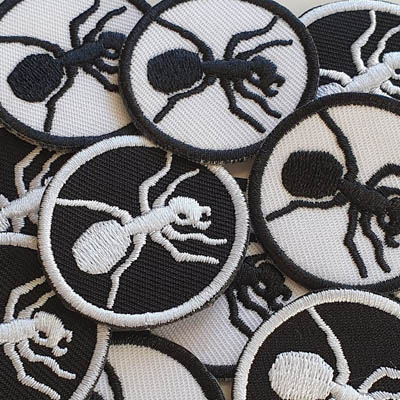
Trending
31 Dec 2011 Sabotage Times
The Prodigy Interviewed: “No more snorting cheap speed and banging pills up my arse”
06 Sep 2019 Music Business Worldwide
Peermusic UK signs the Prodigy’s Maxim Reality to exclusive global publishing deal
02 Nov 2017 South China Morning Post
Liam Howlett of The Prodigy on ‘fake controversy’, the band’s fired-up frontman Flint and new ‘old’ album ahead of Clockenflap
01 Aug 1992 Mix Mag
Did Charly Kill Rave?
30 Jul 2019 MusicTech magazine
Prodigy engineer/co-producer Neil Mclellan remembers the Jilted Generation sessions
